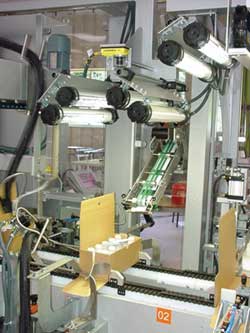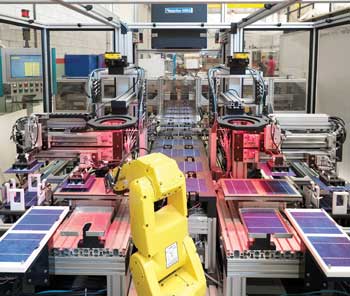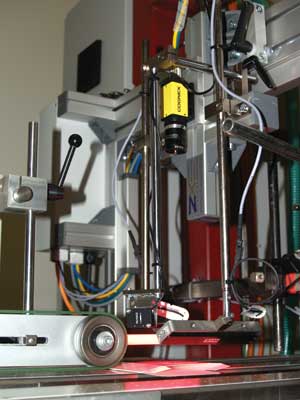If seeing is believing, it’s easy to understand why industrial inspection needs vision. Imaging a part may be the only way to monitor production as it occurs and check final output quality. Given that, one question is how to select the right camera. A survey of manufacturers reveals some tips to make sure that what is seen is both believable and affordable.
First up is Cognex of Natick, Mass. It supplies vision systems and software as well as industrial bar-code readers. In choosing a camera, it’s best to start with the basics, said John Lewis, market development manager.
“To find the best camera for any given application, you have to start with the object of interest,” he said. “What size is it? What field of view is required for the inspection? Then determine working distance, resolution, depth of field and sensor size.”

For an application during the manufacture of the liquid that is injected during MRI scans, Cermex, a specialist in end-of-line packaging machines, specified a smart-camera vision system to verify the number of flasks placed in cartons and to ensure that a required document is present in each one.
Answering such questions may not be straightforward. For instance, a part could be passing by on a conveyor, with its position potentially at any point along the belt width. In this unfixtured case, the field of view needed will be considerably larger than the object itself.
Similarly, the object’s distance from the camera may be variable, or the part mix may change. In those cases, an autofocus capability could be important, Lewis said, because automatic camera focus adjustments ensure that images remain sharp.
Autofocus also can increase throughput. Often, inspection cameras are located in difficult-to-reach places. Without autofocus, camera adjustments have to be made manually or in a semiautomatic fashion, which can take time.
For most industrial applications, a monochrome camera, along with the right lighting and suitable filters, is the best solution, Lewis said. Ideally, the target of the inspection – such as a foreign object – will show up brightly against a dark background, or vice versa. Determining how to achieve such contrast requires knowledge of the application and vision expertise.
Industrial inspection cameras may be mounted in tight spots, in which case compact systems have an advantage. In some situations, the field of view may be very restricted, such as when a camera peers up through gaps in a transport system. Here a line-scan, instead of an area-scan, camera may be better. The former scans a single-pixel-high line; the latter images a rectangle.
How the camera is packaged is also important. Industrial settings are prone to temperature extremes, vibration and dust. In food processing and other applications, equipment can be washed down with jets of water.

Ikusmen, a Spanish systems integrator, turned to a smart-camera vision system to calculate cell position and orientation for robotic alignment, and to detect cell defects at solar cell manufacturer Gorosabel. Photo courtesy of Cognex.
“That’s why we offer IP-67- and IP-68-rated smart-camera vision systems – to eliminate the need for accessory enclosures and to simplify installation,” Lewis said. The ingress-protection ratings cited indicate that the enclosures are dust-tight and can be immersed in at least a meter of water.
From its headquarters in Waterloo, Ontario, Canada, Teledyne Dalsa offers area- and line-scan cameras, smart cameras, vision software and frame grabbers. When asked what steps should be taken to assess inspection needs and possible camera solutions, technical sales engineer Samuel Biancuzzo noted that, at times, vision is needed to satisfy quality requirements. Laser engraving of glass or other materials, for instance, may demand a visual quality check.
Other reasons to use a camera are safety concerns and liability. There may be a need, for instance, to make sure there are no sharp edges on bottles. For consumer products, at least, liability requirements are such that a need for vision inspection probably will always remain.
This can extend to items that are normally invisible. An example might be a bacterial contaminant in packaged meat. Ultraviolet light can cause the unwanted bacteria to fluoresce, thereby making the contaminant detectable using a vision system.
As for camera resolution, that depends upon the inspection setup, Biancuzzo said. If the area to be surveyed is relatively small – say, a foot wide – then virtually any industrial camera will probably suffice. If the area is larger, a camera with greater resolution may be needed.

Artur Theis GmbH & Co. KG of Wuppertal, Germany, uses a smart-camera vision system to measure label position. The system ensures proper label placement with specified tolerances and identifies possible defective products so they can be reliably removed.
The speed of the camera must be sufficient to keep up with the demands of the production line. Here, the camera interface can play a significant role. Two of the most popular connection standards are GigE and Camera Link. The first is based on Gigabit Ethernet technology, while the second is specific to machine vision. At its fastest configuration, Camera Link offers speeds of up to 5.44 Gb/s, or more than five times that of Gigabit Ethernet. That greater data capacity has an effect on camera capabilities.
“Two of our newish cameras, the Genie TS and Falcon2, feature our own CMOS image sensor. The GigE version will capture 19 frames a second, and the Camera Link version will image at 90,” Biancuzzo said. He noted that the application determines which interface is needed.
Proper and consistent illumination is vital to the success of any vision inspection system, Biancuzzo added. For that, LED lighting offers the best solution, with lasers providing another good choice.
Matrox Electronic Systems of Dorval, Quebec, Canada, sells both software and hardware for machine vision applications. The question of illumination often involves both the light source and the camera, noted Fabio Perelli, smart camera product manager. A camera with lower dark noise, for instance, may mean that less is required of lighting in terms of intensity and overall performance.
However, lighting and optics represent about 80 percent of the solution to an inspection problem, he added. The rest is handled by the camera – and perhaps a bit of engineering ingenuity.
Perelli recalled a case where a customer wanted to inspect units being assembled, which meant that fasteners had to be imaged. The problem was that the machines attaching the fasteners obscured the view. The visual inspection was a retrofit, and the company didn’t want to completely revamp the production line or manufacturing methods to accommodate a camera.
The solution was to capture the image as the part moved away. That, in turn, created a set of requirements for the camera’s speed that otherwise might not have been needed.
“A high frame rate really freezes the image. You put in good lighting, and you get a nice, steady-state picture,” Perelli said of the solution. He noted that requirements like this could play in the sensor choice for the camera. A CCD image sensor offers lower frame rate imaging than a CMOS sensor. Thus, if the need for speed is paramount, it may be best to go with a CMOS sensor-based camera. The two sensor technologies are comparable in cost and quality, with CMOS typically being less expensive and probably offering lower-quality imaging, according to Perelli.
Some final tips on camera selection come from Ahrensburg, Germany-based Basler. The company makes a wide range of industrial and network cameras, said Joachim Linkemann, senior product manager of customizations. Basler supplies area-scan, line-scan and network cameras for industry, transport and video surveillance applications.
Linkemann’s advice to prospective camera buyers is to consider resolution, size, interface, signal-to-noise ratio, dynamic range, quality, price and other factors. It’s difficult to point to any one as being the overriding reason to pick a given camera because application preferences vary. However, there is a rule of thumb that should be followed.
“In total, a good price-performance ratio is always good,” Linkemann said.
Resolution is a tricky topic when it comes to selecting an industrial camera. On one hand, it allows finer details to be imaged – if the optics and lighting are up to the task. On the other hand, there are drawbacks that affect the camera and the rest of the system. For the latter, more pixels translate to more data that must be transported and processed. Consequently, any image will consume more network and computing resources.
Higher resolution can bring problems, too, Linkemann said. Pixels are often smaller, which means a lower signal-to-noise ratio and a more limited dynamic range. Such negatives may not be offset by the ability to image greater detail, as the optics may limit resolution.
Over the past decade, Basler said he has seen color go from being found in 20 percent of industrial cameras to about one out of every three units the company ships. For certain applications, such as inspection of printed material, camera color fidelity is important. But, color is often implemented because it makes things easier on people.
In the selection of pixel size, the question of color can play a role. Color cameras are often equipped with a Bayer filter pattern, with most pixels imaging green. The remaining pixels image either red or blue. This configuration necessarily reduces the effective pixel count and the resolution. That situation affects the advice Linkemann offers.
On sensor pixels, he said, “A good compromise is a 5-µm pixel size for monochrome sensors and 2.5 µm for color cameras equipped with the Bayer pattern.”